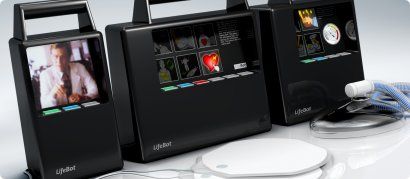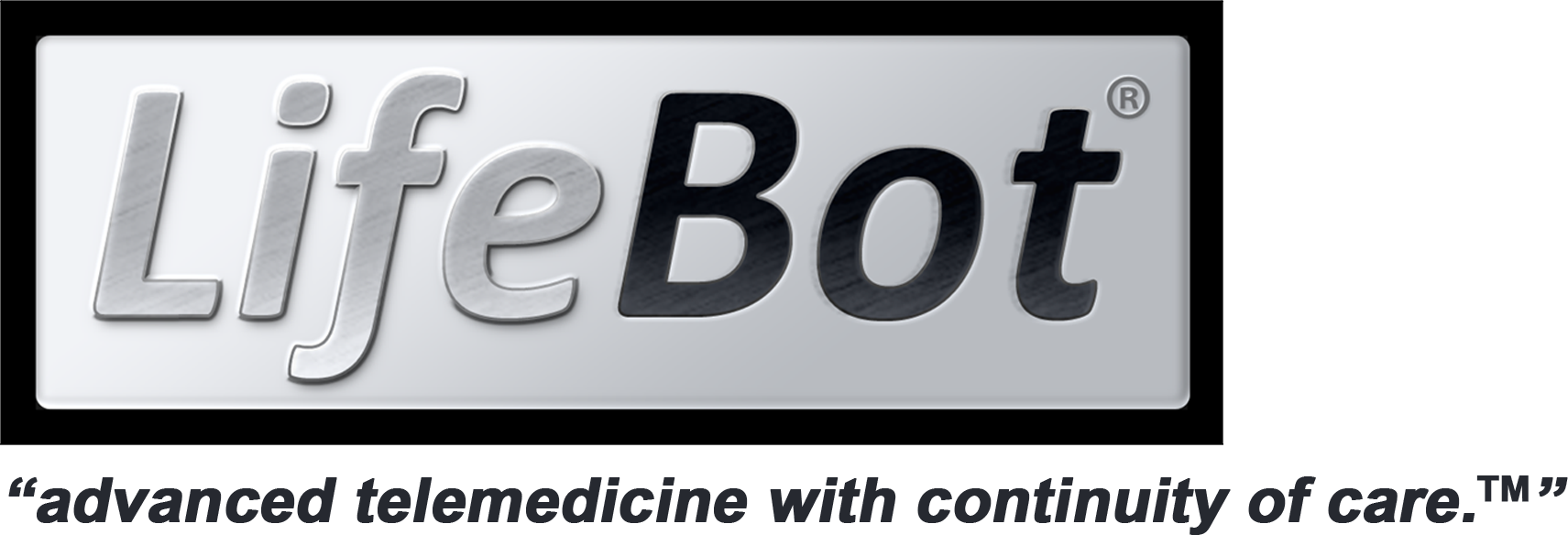
Phoenix, AZ, USA September 8, 2011 : Cardiac defibrillators, used to shock heart arrest victims back to life, are in widespread use throughout the world today. They are in virtually all hospitals, most ambulances, at airports and major public gatherings, aboard airplanes and sea going vessels. They are implanted similar to pacemakers. But, what if defibrillators could use 80% less energy? Could they be much smaller lighter and cost less? Would there be less pain and heart tissue damage?
Most of this is possible according to CEO and founder R. Lee Heath. With his 32nd patent issuing, LifeBot® is even better positioned to deliver these exclusive resuscitation and telemedicine technologies. LifeBot® is focused on the use of remote telemedicine to manage critical emergency life saving procedures.LifeBot® announced today that founder, R. Lee Heath, has received Notice of Allowance from the U.S.P.T.O. of his 32nd patent focusing on integration cardiac defibrillation and telemedicine robotics.
New Reports: Successful Defibrillation with 80% Less Energy:
Researchers in the U.S. and Germany surprised everyone just a few weeks ago announcing the results of their extraordinary studies showing that defibrillation may be performed using counter-shocks with almost 80% less energy. The studies were done on internal procedures with electrodes connecting directly to the heart. But, according to Heath, it is just a matter of time before this area of research will have an impact on external procedures as well. Each study demonstrated that a series of small shocks could produce similar results to that of a large single counter-shock or the conventional method most commonly utilized by all defibrillators today.
According to Science Daily, “An international team of scientists — from the Max-Planck-Institute for Dynamics and Self-Organization (Göttingen, Germany), Cornell University (Ithaca, New York) the Ecole Normale Supérieure de Lyon (France), the University Medicine Göttingen (Germany), the Rochester Institute of Technology (USA), and the Institut Non-Linéaire de Nice (France) — has developed a new low-energy method for terminating life-threatening cardiac fibrillation of the heart. They have shown that their new technique called LEAP (Low-Energy Anti-fibrillation Pacing) reduces the energy required for defibrillation by more than 80% as compared to the current conventional method. Their discovery opens the path for the painless therapy of life threatening cardiac fibrillation.”
The LifeBot® – A Telemedicine Robot to Keep You Alive™:
According to Heath, the methods used in the above studies are the same methods reflected within his patent already issued by the USPTO. ( US Patent # 7,672,720 , Domestic and International Patents Pending. ) Heath was very gratified to see the research by such esteemed institutions affirming his already patented methods. Heath also stated that, in his opinion, this research only “scratches the surface”. There is more work to do to carry this into widespread use for both implantable ( Internal Cardiac Defibrillators or “ICD” ) and external ( Automatic External Defibrillators or “AED” ) systems. Either way, Heath’s already awarded patent is designed to apply to both instances of use.
Smaller size and weight with reduced cost? “Yes”, says Heath, “The external defibrillator prototypes we have constructed and tested some time ago are only about one and one-half inches square.” This has given rise to speculation that these systems could be integrated or added to a PC, tablet, or even a cell phone. This has already been the subject of additional patent documentation on file at LifeBot® for some time.
The patent covers the unique concept of a “Telemedicine Robot” or “LifeBot®” or life support communications system that any one may use under very adverse circumstances. Integrated is the ability to trigger remote telemedicine so a doctor or nurse is virtually “on-the-scene” to aid the patient and/or rescuers. Contact with 911 or 999 dispatch may also be independently initiated as well. Electronic or Personal Medical Record ( EHR or PCR ) may be immediately shared as well as GPS and common location records.
The “robot” may even initiate emergency calls for help if the owner is alone and collapses or becomes completely disabled. Some have termed the LifeBot® as, “OnStar® for your home or business”, but the system goes much further. The product will be made available to consumers for personal use “over-the-counter” the same as existing AEDs.
It goes without question the LifeBot® will be an invaluable life-saving tool for use by paramedics and lay rescuers. It should also be noted that the patented system is the first and only design to fully integrate and automate the American Heart Association’s recommended “Chain of Survival” which says dial 911 first before deploying an AED. There is no easy breakdown in this chain when using the LifeBot®. No doubt, paramedics and rescuers will love carrying substantially smaller more cost effective defibrillators.
Sending patients that may be at risk home is a difficult and potentially very risky prospect for both hospitals and physicians. The concerned physician can send the patient home with a LifeBot® knowing that an emergency system has been put in place should the most dire of consequences arise.
Many patients are in denial and very hesitant to dial 911, but with the LifeBot® most agree that patients will likely call much earlier for a telemedicine consult to assess whether symptoms are potentially serious. The prospect of patients calling with the earliest symptoms is an idea readily embraced by members of the Sudden Cardiac Arrest Association and the Chest Pain Society.
32nd Patent Notice of Allowance – A Legacy Continued:
R. Lee Heath is best known as the inventor making possible the modern Automatic External Defibrillator (AED) through his patented electrode defib-pads ( R2-Pads or Combo-Pads ) that are placed on the chest to shock cardiac arrest victims. He was recommended for the Lemelson MIT Prize by American Heart Association officials and other peers. The first use of his earliest inventions has placed him in cardiac electrophysiology labs around the world, where he has conversed with the most prominent cardiologists about procedural and theoretical treatment methods for more than thirty years. “This is how it happened”, says Heath.
Now that legacy is continued with the Notice of Allowance for his 32nd patent now issuing. This patent specifically addresses his latest defib-pad electrode designs. The designs are not only corrective of many serious problems that exist, but it is also complimentary to the LifeBot® Telemedicine Robot™ already patented. The two patents form the basis of a complete comprehensive end-to-end personal life support system and advanced paramedic or lay rescuer system design. Integration of the two preserves features for delivering quality and continuity of patient care.
Priorities and Long Term Goals:
On August 17th, LifeBot® acquired the exclusive world-wide rights to the most advanced emergency telemedicine technologies called DREAMS™ ( Disaster Relief and Emergency Medical Services) developed by Texas A&M University, Texas Engineering Experiment Station, UTHealth Houston, and the U.S. Department of the Army. The Digital EMS Project was funded by more than $14 million from the Telemedicine and Technology Research Center (TATRC) an office of the U.S. Army Medical Research and Materiel Command, Defense Department agencies.
LifeBot® is currently pursuing accounts that represent the potential for immediate military use of DREAMS™, whole state’s and whole nation’s standardization on DREAMS™ for use primarily for hospital to ambulance telemedicine. So the number one priority of the Company is the marketing and deployment of the DREAMS™ telemedicine systems. Those who use existing LifeBot® products, including DREAMS™, will save money by easily launching the more advanced patented solutions in the future.
Long-term the plan is to pursue deployments of the LifeBot® Telemedicine Robot™. Market research indicates the annual defibrillation markets exceed $10 billion annually. LifeBot® estimates that the total consumer markets for the robot exceed $70 billion. The Company may consider an additional equity financing to accelerate this to the fore-front. This is especially true in light of the results demonstrated by the very recent research in Germany and the U.S. supporting the Company’s patented methodologies.
“Most very large telemedicine firms have been investing billions in home remote monitoring and this undoubtedly will reduce healthcare costs. But, they seem to have “skipped over” or completely forgotten that most of these patients are going to have an emergency. This is inevitable.”, states Heath, “So emergency management is critical to saving more lives and LifeBot® holds the exclusive patented technologies to make this possible.”
References and Links:
- Science Digest, “A LEAP in Controlling Cardiac Fibrillation: Researchers Develop a New Low-Energy Defibrillation Method”, http://www.sciencedaily.com/releases/2011/07/110714072907.htm
- Nature.com, “Cardiovascular disease: Several small shocks beat one big one” http://www.nature.com/nature/journal/v475/n7355/full/475181a.html?WT.ec_id=NATURE-20110714
- Nature.Com, “Low-energy control of electrical turbulence in the heart” http://www.nature.com/nature/journal/v475/n7355/full/nature10216.html?WT.ec_id=NATURE-20110714
- About R. Lee Heath and LifeBot – Numbers List of Awarded Patents view more..
- LifeBot: “LifeBot Acquires World-Wide Rights to DREAMStm “Super Ambulance” and Emergency Telemedicine Technologies”
view more.. - mobihealthnews.com, “Interview: Roger Lee Heath’s LifeBot and Super Ambulances”
view more.. - LifeBot Commentary by R. Lee Heath , “Video Teleconferencing is NOT Telemedicine!”
view more.. - Hewlett Packard, “Ambulance 2.0: Bringing Doctor-Quality Care to Ambulances” view more..
Related Media Download Links:
a. High Resolution Image LifeBot Telemedicine Robot: LifeBotTelemedicineRobot.jpg
